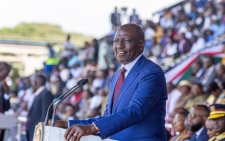Linking SGR, metre gauge lines will spur regional growth
Virginia Munyao
Kenya’s rail transport sector is set to witness an unprecedented growth trajectory, thanks to the refurbishment of the Metre Gauge Railway (MGR) and ongoing works to link it with the Standard Gauge Railway.
The revitalisation of the MGR is economically beneficial to the counties on the railway corridor through provision of faster, reliable and safe transport means for high capacity haulage of freight; reducing carbon emissions; reducing wear and tear of the roads; reducing congestion and potential accidents as well as provision of effective utilisation and security of railway assets.
It also supports the implementation of the Big Four agenda of Manufacturing, Universal Health Care, Affordable Housing and Food Security.
The use of the completed Nairobi-Nanyuki line, for instance, has eased congestion on the roads and reduced maintenance costs. It has also reduced commuting time, minimised carbon emissions and provided safe, reliable and affordable services.
One of the immediate impacts of the project has been an increase in the running speeds of the trains from 20kph to 50kph.
In the long term, the branch could be extended northeast from Nanyuki to a connection with the planned Lapsset (Lamu Port–South Sudan–Ethiopia Transport) corridor at Isiolo, with a further connection running west to Nyahururu.
The Gilgil–Nyahururu branch connecting with the main line through the Rift Valley is one of several metre-gauge branches which the government has committed to rehabilitate as part of a programme to improve the transport of bulk freight and revitalise rural areas. Other routes include Voi–Taveta, Eldoret–Kitale and Kisumu–Butere.
Historically, the rail transport sector line has played a great role in the growth of our nation.
This occurs during the construction and operation phases mainly through job creation. The sector creates thousands of jobs both directly and indirectly.
Currently, thousands of Kenyans are gainfully engaged in the rail transport sector.
During the construction of the SGR and the ongoing revitalisation initiatives on the MGR, large quantities of local resources are being utilised on the project.
The SGR&MGR line will have a huge multiplier effect on the economy by moving goods and people. Notably, the months of July and August have seen a very sharp rise in the number of travellers, especially tourists heading to Mombasa.
The net effect is the re-opening of coastal hotels and the re-hiring of staff after a slump occasioned by Covid-19.
As of the 31st of July, over 5.8 million passengers had been transported. During the same period, over 1.4 million TEUs were transported safely, as Africa Star Railway Operation Company (Afristar), the SGR operator, ensures safety of goods on transit, passenger safety, occupational safety as well as safety of communities along the track.
Regional trade has also been enhanced due to easy movement of freight and passengers, in turn impacting the country’s and the region’s tourist potential and exploitation of resources.
Regional integration efforts will also receive a boost with enhanced rail transport infrastructure.
But most importantly, linking of the SGR and the Metre Gauge Railway line will provide a seamless connection between Mombasa and Kisumu/Malaba.
This will enable transportation of cargo exclusively via rail from Mombasa to Uganda, Rwanda and Burundi.
Key benefits include larger capacity and reduction of transit time for passenger and freight transport services.
The interface between SGR and MGR will also go a long way in decongesting the Port of Mombasa, a key transport and logistics hub in the region.
The throughput at the port is on the rise and is projected to grow to 30 million-plus tons by 2030.
There is therefore need to increase the capacity of transport infrastructure to meet the existing and projected transport demand at the Port.
A seamless connection from Mombasa to Kisumu/Malaba is a sure way to decongest the port. — The writer is a communications adviser, Afristar








